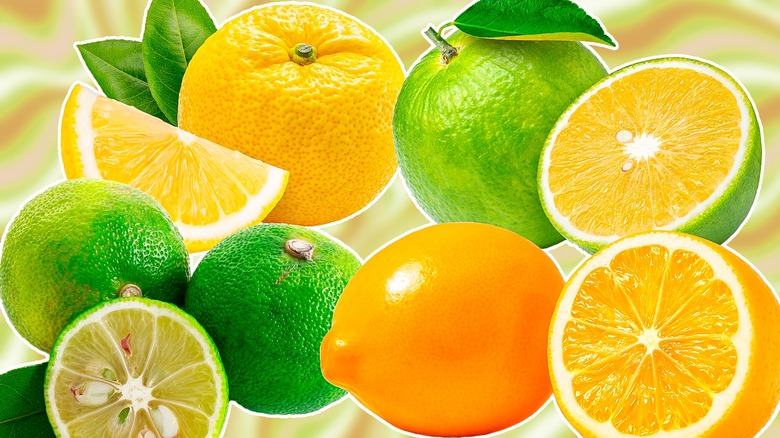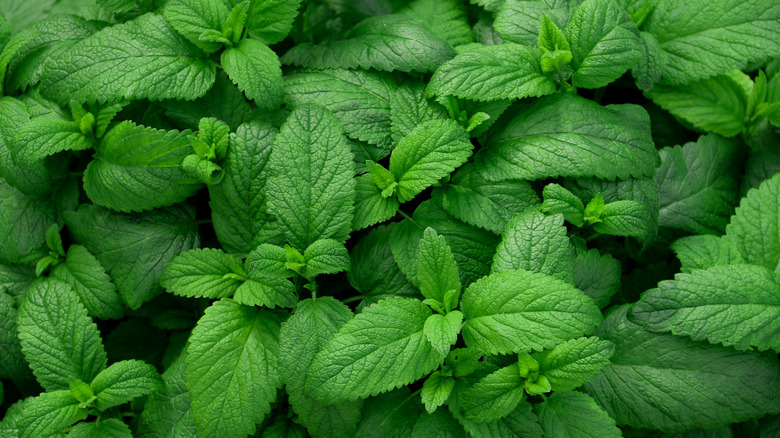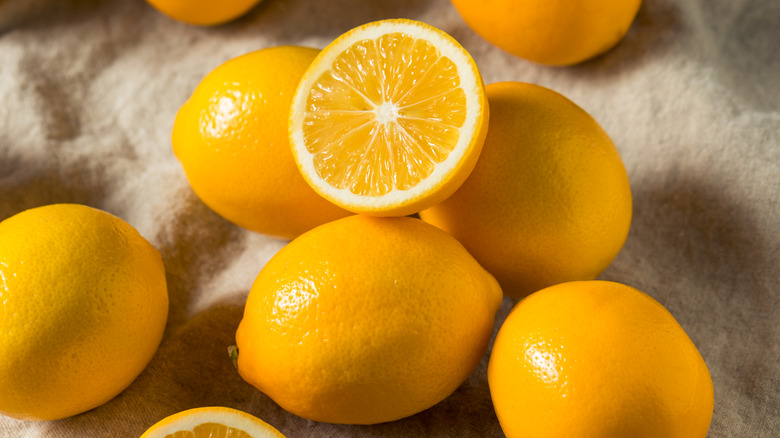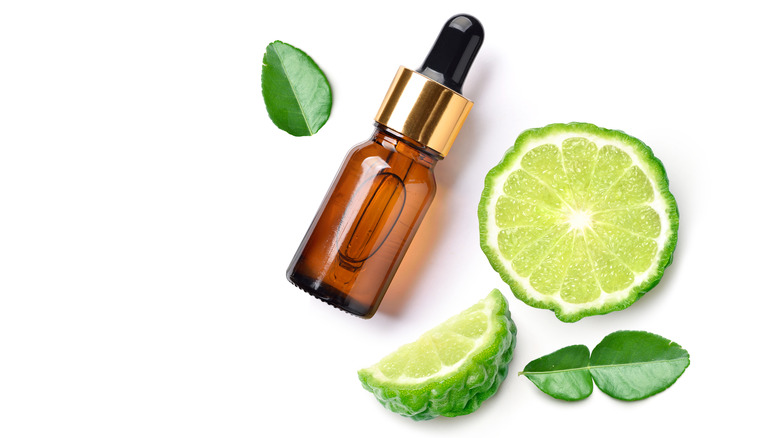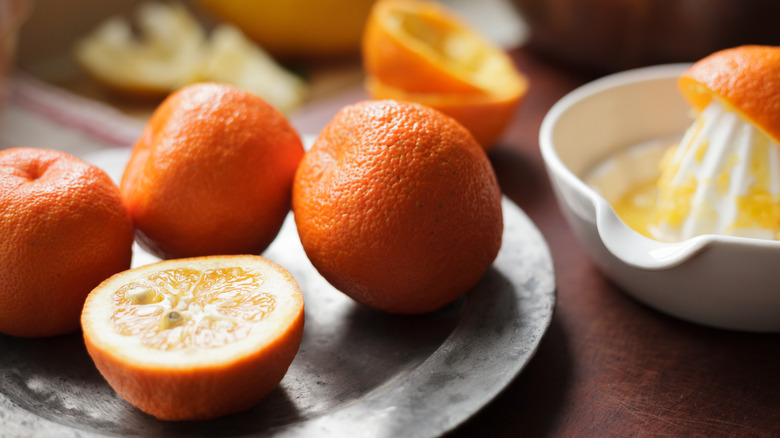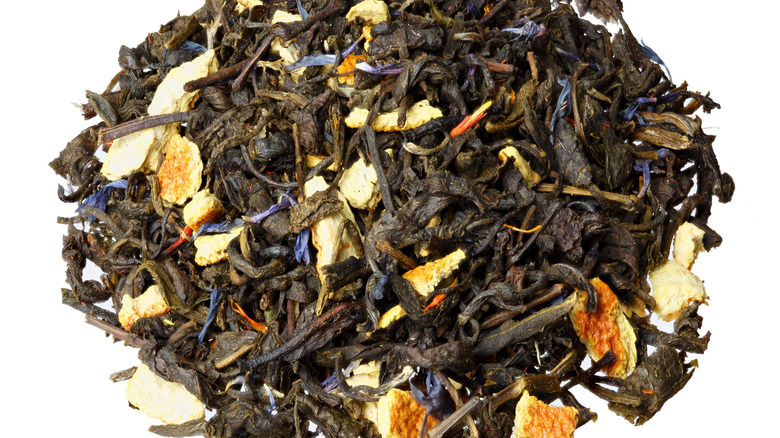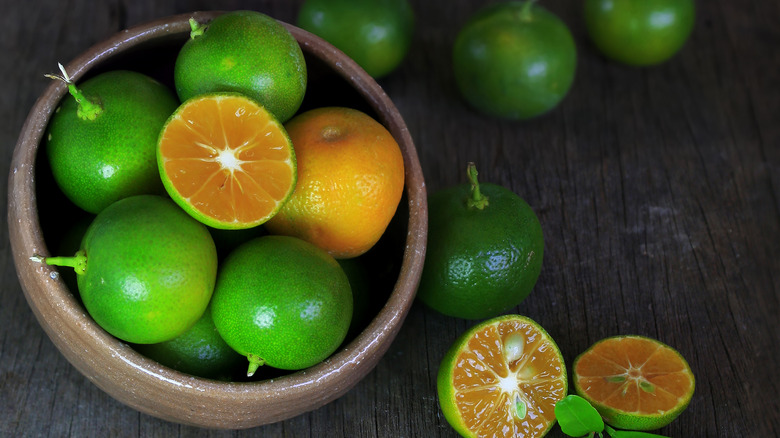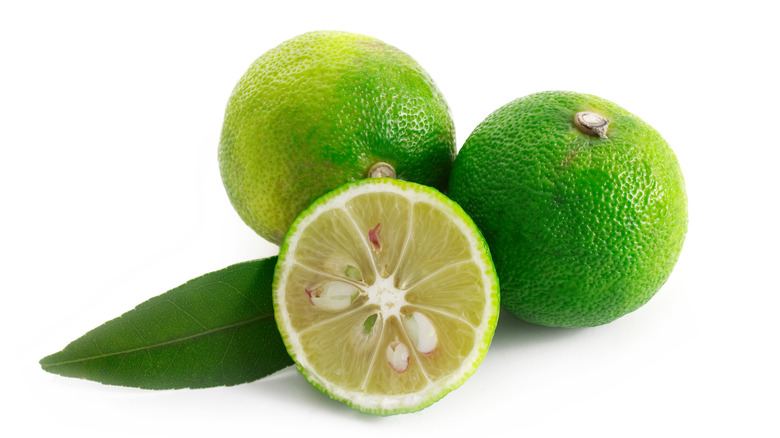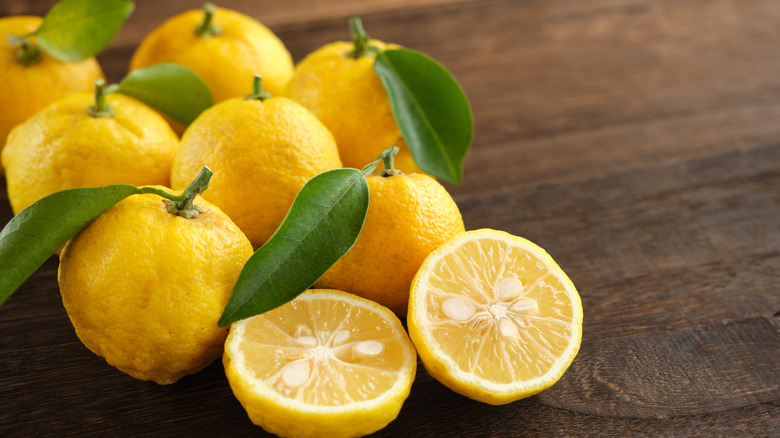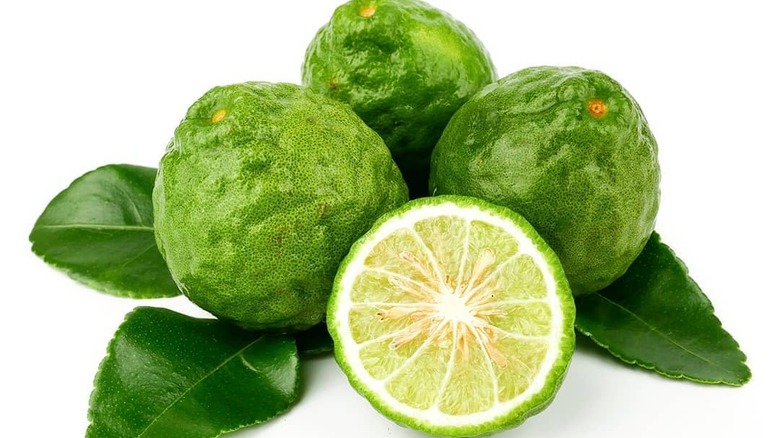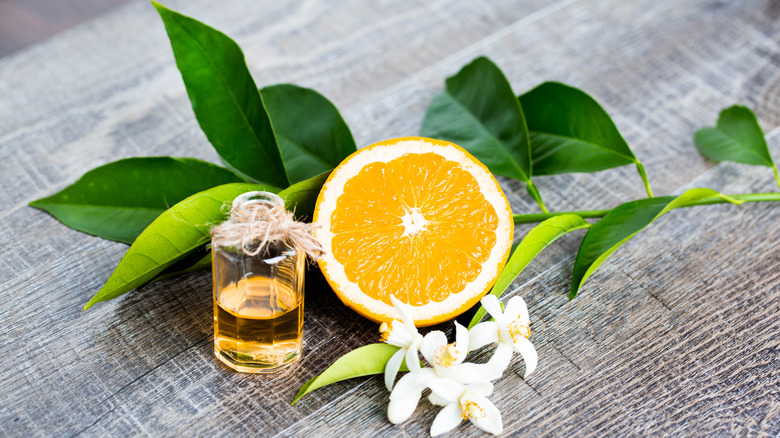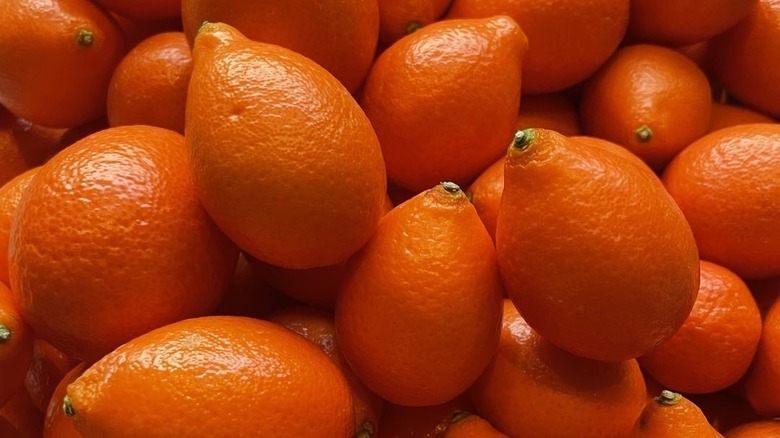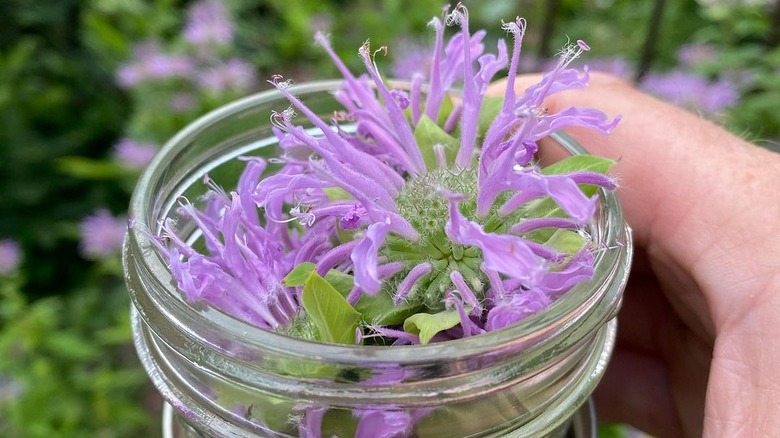12 Best Substitutes For Bergamot
Fresh citrus fruit is like a wake-up call for your tastebuds. The juices are a lightning strike that settles into sweet and sour satisfaction, and they have a bitter burst that can cut through savory and sugary foods with main-character energy. Though most grocery stores only carry a few, there are more than 1,000 types of citrus fruits and citrus relatives in the world. And the best part is that each flavor profile is unique — some are sweeter while others pack a super sour kick. If sourness is more your speed, look no further than the bergamot orange.
Also known as Citrus bergamia, the bergamot is a distinct variety of orange that originates from Southeast Asia and more closely resembles a large-sized lemon or lime. Today, Calabria, Italy is the world's largest producer of bergamot oranges, responsible for over 90%. While its flesh is too sour for most to consume, the bergamot orange's peel is more useful. When used in cooking, it adds a sharp citrus taste that's tart and fragrant. It happens to be the main ingredient that gives Earl Grey its flavor, and it can even elevate desserts, cocktails, marinades, essential oils, and personal care products.
However, bergamot oranges are rare and subsequently tend to be more expensive than other citrus fruits. Fortunately, if you have trouble getting your hands on some or simply want to save some moolah, there are plenty of substitutes you could use.
1. Lemon balm
Lemon balm is one surefire bergamot substitute that's easier to find. Though the name suggests a fruit, lemon balm is a green, leafy herb originating from Europe and Central Asia. It's part of the mint family and has been used for its medicinal properties since the Middle Ages. Studies have proven lemon balm to reduce stress, improve sleep and appetite, and ease indigestion. Its lemony and herbaceous aroma admittedly isn't a perfect substitute for bergamot's flavor profile, but it is perfectly acceptable.
Like Earl Grey, lemon balm is a popular tea. The taste is a subtle blend of lemon and minty sweetness. Since bergamot tastes closer to a lemon than an orange, fresh lemon balm leaves can be used in place of bergamot extract in Earl Grey. If you can find lemon balm extract, you can use that as well. Beyond energy-boosting tea, lemon balm tastes great in many recipes. Use it as a substitute for lemon or bergamot zest, add it to stuffing for roasts, or blend it into salads, syrups, jams, ice cream, and more. Fresh lemon balm is available at major outlets like Walmart and Home Depot, online growers, and even Amazon.
2. Meyer lemons
Lemons are distinctive for being seriously sour. Bergamot oranges may be astringent in comparison to regular oranges, but they pale in comparison to lemons. There is one variety, however, that can work as an acceptable alternative: Meyer lemons.
Meyer lemon juice has 1.3 times less acidity than regular lemon juice. Although less common, they've existed for over a century and have distinct qualities too. Smaller than regular lemons, Meyer peels have a deeper yolk-like orange color with a smooth texture. The peel is also thinner and nearly pith-free, allowing you to bite directly into the fruit without removing it. Taste-wise, it has a complex profile that includes lemon and mandarin orange with floral undertones — the flesh is also noticeably juicier. Overall, Meyer lemons are sweeter and less acidic than you may expect, so you don't need a high sour tolerance to enjoy them fresh.
The sweet taste makes them perfect for lemon-infused cookies, tarts, cakes, and pies, so they can similarly be used for any desserts that feature bergamot. Meyer lemons aren't as effective in savory foods though and tend to get lost in the proverbial sauce. And when it comes to Earl Grey, Meyer lemons are a better complement than a substitute for bergamot.
3. Bergamot extract
Bergamot extract is more common at grocery stores than the fruit itself, which is only available seasonally. Quality Earl Grey tea is typically made with bergamot extract, though more affordable synthetic versions also exist. To get just 85 grams (or 3 ounces) of extract, about one hundred bergamot rinds would need to be used. For reference, a standard-sized soda can is 12 fluid ounces, which explains why bergamot oranges are so rare and expensive. Beyond its culinary potential, bergamot extract has been used in medicine for decades, particularly for aromatherapy.
It's a potent concentration of citrus and an acceptable alternative to the bergamot fruit itself. You can easily find it online too. If, by divine intervention, your local grocery store currently carries bergamot oranges, making extract at home is easy. For every 4 medium bergamot oranges, you need 1 quart of high-quality vodka — bergamot oranges are about the size of a regular medium orange. Place the orange peels into a mason jar and submerge them in vodka. Put the lid on the jar tightly and seep it for at least a week.
After you've extracted the citrusy magic within, there are countless recipes to try. You'll impress your significant other by swapping bergamot extract into this glazed salmon and cranberry balsamic compote. For something fresh yet filling, try infusing this herby tabouli recipe with bergamot flavor. And, of course, you can always use it to make homemade Earl Grey sweet tea.
4. Bitter orange oil
Bitter orange oil, also known as Seville or sour orange, is another citrus substitute worth considering. Though it lacks the distinctive floral accent that bergamot carries, both are members of the bitter (or sour) orange family, so using it as an alternative will work just fine. Despite its various names, it's typically labeled as simply bitter orange oil. These unique bitter oranges are used for British marmalades, fresh sauces to pair with savory recipes, and this citrus can even be used to save undrinkable wine.
Unlike bergamot, the flesh is reddish-orange when ripe — but the peel is similarly thick and textured. With an undeniably sour zing, both the oil and zest work as a bergamot substitute. They will satisfy your citrus needs but don't expect the same nuanced flavor profile. That said, bitter orange-infused Earl Grey isn't half bad either. From jellies and candy to chutneys and more, bitter orange oil is a perfectly suitable bergamot alternative. Oil extracted from the peel is also sold as a supplement to aid in weight loss, skincare, and brain health.
5. Earl Grey tea
Though it may come as a surprise, Earl Grey tea is a pretty great bergamot substitute. It has a noticeably intense citrus taste and a bold balance of maltiness. The bergamot-infused leaves pack a potent punch paired with earthy black tea leaves, so you'll have to experiment with different amounts to determine the best conversion. We'd advise against using cheaper brands because many include artificial flavoring, which is safe for people with citrus allergies, but it doesn't offer the same refined experience. The real thing is always the better option.
Natural bergamot can vary in flavor depending on where it was cultivated and how it was processed. That means that you'll always get to experience new and exciting citrusy profiles. Along with a natural taste, you'll benefit from its life-supporting nutrients. That's a better reason than most to pay more for a premium brand. If anything, a fresh bergamot aroma is the real indicator of quality.
When bergamot is out of season and the extract is out of stock, Earl Grey is a surprisingly effective substitute. There are also lots of Earl Grey tea desserts and drinks to try.
6. Calamondin juice
The next citrus alternative hails from China and packs a sourness akin to limes. Calamondins, also called calamansi, are a hybrid of kumquats and mandarins. They look like smaller clementines and measure 1 inch in diameter. The skin is smooth and sweet, unlike bergamot's, which is bumpy and bitter. Both have super sour flesh, but calamondins are more acidic. In other words, they are a great bergamot substitute if you don't mind a more astringent aftertaste. Another plus to these tart treats is that they are available year-round.
It would help if you experimented with doses when substituting bergamot extract with calamondin juice, as using too much will make dishes overwhelmingly sour. From marmalades and marinades to beverages and desserts, there are many ways to incorporate calamondin juice into everyday eats. You can spruce up a soirée with this refreshing homemade limoncello alcohol with calamansi recipe. Calamondins are among the popular ingredients in Filipino cuisine as well, with locals calling them the Philippine lemon and lime. If your go-to grocery store doesn't carry them, try purchasing calamondin extract or concentrated frozen calamondin juice online.
7. Sudachi limes
Another great source for astringent tastiness is sudachi limes. Originally cultivated in Japan, they range in color from bright green to yellow-orange when mature. Sudachis have an intense tart taste with subtle notes of cumin, dill, and pepper. The extract, zest, and juice are primarily used in cooking for flavor. Interestingly enough, these special limes are most flavorful when immature. They deliver a superior sour kick compared to bergamot — and better yet, are available throughout the year.
Less sudachi lime juice is required to replicate the sourness of bergamot, so you must be mindful when subbing. Sudachis are commonly used as an alternative to vinegar, which underscores how acidic they are. Their unique flavor profile will also introduce aromatics that bergamot does not. That said, sudachi juice can be added to dressings, dips, marinades, and sauces just like bergamot. The juice and zest can also help mask the odor of seafood. In Japan, adding it to noodle dishes, stir-fries, and rice-based dishes is popular. Along with savory recipes, sudachi limes pair impressively with ice cream, cookies, cakes, and more.
8. Yuzu Fruit
One citrus that is important to Japanese cuisine is yuzu fruit. Yuzu has been grown in the country for well over 1,000 years. It resembles a bright yellow mandarin, and the flavor carries a sourness similar to a grapefruit. These zingy fruits are not only popular ingredients in Japanese cuisine, but they are famously medicinal — just 3.5 ounces will provide plenty of essential vitamins like C, A, and B6.
While yuzu fruit is widely available in East Asia, it's harder to find in the United States due to strict import guidelines. Of the four varieties grown in Japan, hon yuzu is the main type — and the tartest option. In a side-by-side comparison, yuzu has smoother skin and a sweeter taste than bergamot's more distinctive floral undertones. So don't expect the same aromatics or level of sourness when substituting it with yuzu fruit. It may not be a perfect match, but yuzu fruit will definitely provide the citrus experience you want.
9. Makrut limes
Southeast Asia is home to another popular citrus variety named makrut (aka Thai or kaffir) limes. They commonly feature in the local cuisine and not only impart flavor but also nutrients. If you've had Thai food before, you've likely tasted this variety's aromatic sourness. They look fairly similar to green bergamot oranges but are completely distinct. The peel is thicker for one. And though not as potent as regular limes, they also trump bergamot on the sour scale — so you don't need much juice when using them as a substitute.
To incorporate makrut limes into your cooking, purchase its extract online. In addition to flavoring teas, it tastes great in desserts, cocktails, and countless savory dishes. Beyond Southeast Asia, makrut limes are also popular in Creole cuisine. Makrut lime leaves can be used in cooking too, although they have a peppery taste, rather than citrusy. The leaves feature more commonly in Southeast Asian cuisine than the fruit itself, and using both helps reduce food waste.
10. Orange blossom oil
The fruit and leaves of an orange tree are not the only parts that produce citrus — it also grows flowers called orange blossoms. White, oval, and fragrant, they have a citrusy aroma combined with a complex floral array of tuberose, jasmine, fresh grass, and nutmeg. In cooking, orange blossom is most often used in oil form. This extract is sufficiently sweet and sour, making it a great substitute for bergamot. You can eat the petals raw but may not enjoy their soapy and bitter aftertaste.
With its intense blend of citrus and flower, orange blossom oil offers much of what you expect from bergamot. However, bergamot extract isn't sweet, so infusing Earl Grey tea with orange blossom oil will result in an entirely different experience. That said, it works just as well in sweet and savory recipes as bergamot does. But watch out for its robust kick, which can easily overpower a dish.
While it's possible to make orange blossom oil at home, save yourself the measuring and boiling and purchase it pre-made instead. Just make sure that you search for the kind used for culinary purposes rather than the fragrant essential oil. Meanwhile, orange blossom water is a diluted option that's cheaper than the pricier pure oil. Orange blossom water should actually always be in your pantry: It's a staple ingredient in Middle Eastern, North African, and Mediterranean cuisines, and often appears in French, Spanish, Italian, and Greek desserts.
11. Mandarinquats
You'll love the tear-dropped-shaped citrus fruit called mandarinquats. As the name suggests, they are a hybrid of mandarins and kumquats. When cooking with this citrus, it provides the former's sweet pepperiness with the latter's citrusy tartness. Unlike bergamots, no peel removal or poking with straws is necessary, and mandarinquats are also much more likely to be consumed whole. Originating in Indio, California, its flavor starts fruity before becoming tangy. Sourness is definitely present, but it's balanced by saccharine juiciness. One incentive to use them as substitutes for bergamots is availability, as many grocery stores stock mandarinquats when in season. You can typically find them in the winter through the beginning of spring.
We don't recommend mandarinquats if you want something closer to the bitterness of bergamot — but if you want a burst of citrus and sweet, you've come to the right grove. There are countless ways to use this citrus in the kitchen because it complements a wide range of flavors. Fresh mandarinquats can be added to salads, pressed juices, and yogurt. The flavor profile pairs deliciously with cookies, breads, cakes, and other baked goods too. You can even infuse syrups, marinades, and vinaigrettes with mandarinquat zest and juice.
12. Bergamot herb
This next surprising bergamot substitute has the same name but is not even a fruit. The bergamot herb is a perennial plant that originates in North America and is also known as Monarda fistulosa and bee balm. It's commonly spoken of interchangeably, yet it's herbaceous and peppery rather than citrusy and floral. You'll find the smell and taste reminiscent of thyme or oregano thanks to its high thymol concentration, a component of thyme essential oil that's not only anti-inflammatory but also antiviral and antibacterial.
The bergamot herb is less of a substitute for the fruit as it is another culinary experience. Its herbaceous profile is the perfect complement to Italian cuisine and can be used fresh or dried. Keep it classic with this lasagna bolognese recipe or put a peppery spin on this homemade Margherita pizza. Beyond the boot-shaped country, the bergamot herb has numerous uses. Spicy and slightly bitter, the leaves taste excellent in tea or as an added flavor for fruity beverages. You can also make bergamot sauce to go with a savory pork filet, giving the dish a minty spiciness.
Honestly, any recipe that calls for oregano or thyme can get the bergamot treatment. It's typically sold in dried or powder form online. Although pretty affordable, you can also grow it at home — even indoors. With sufficient light, the seeds will germinate between 10 to 28 days.
